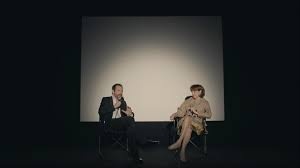
Joanna Hogg’s third feature, EXHIBITION, is that rare thing, a film about the middle class that doesn’t involve infidelity, divorce, children (troublesome or otherwise), an incurable disease, death or murder. It is about two artists, one an architect H (Liam Gillick) the other a performance artist D (Viv Albertine) living and working in the same house, a three storey modernist construction by the late architect James Melvin, whose singular features are a spiral staircase that goes almost to the roof, sliding wooden doors and vast living space; you might be reminded of the Tracy residence in the THUNDERBIRDS marionette TV series. Except for one shot when H is sweeping water off a flat roof, the film is told from D’s point of view. We first see her lying by the window, nestling against the wall, as if wanting to see what lying so close to a partition between her and the noisy, abrasive outside world might feel like. At various points we see D reflected in the window; ostensibly we see what’s outside, but there are traces of her in the image. She is almost swallowed up in the frame, especially when her reflected image shares it with the vast waving foliage of the trees outside. The sounds outside and above D are amplified by the building; in spite of the space, the house feels claustrophobic.
After some 20 years living there, D and H have decided to sell it. So in a way, it follows the other sub-genre of middle class film is ‘moving on’, except that we don’t see where they are moving to. This is a film about leaving behind and how spaces are transformed by the lives within them. The very room that seems oppressive to us becomes a playroom for children, equal to the noise outside.
That D and H don’t have children is important; it contrasts them sharply with their friends, who are rendered anxious by their teenage son. A meal is held in their friends’ house and the wife cannot resist wanting to check on the boy, whom she claims is skirting close to an ASBO. D, our viewpoint character, faints in response, expressing our disdain for this excessive and ineffectual parental concern.
Hogg makes films without scripts. There is a situation and the actors are introduced to a location, but then are given things to do by their director. (I’m almost tempted to write ‘silly things to do’, in honour of the radio show I’M SORRY I HAVEN’T A CLUE; it feels like that, oddly.) Unusually, both Albertine and Gillick lived in the house for the duration of the shoot in order to cement their relationship to the space. As Albertine explained at a recent question and answer session, they would awake to the sound of the crew arriving who would inevitably take all the bread. Then they would set up and Hogg would offer five lines that would suggest a subject for conversation. 95% of the scenes shot didn’t make it into the movie; what we see (as in a Mike Leigh film) is the distillation of effort.
Mike Leigh’s films are a useful point of contrast. Like Hogg’s work, you sense a distance from the characters, but Leigh photographs performances, the results of transformation into characters, all behavioural tics. Hogg casts actors close to the character so that performance seems natural, though at various points Albertine has to ‘perform’, sitting on the edge of an upturned chair or standing on a spinning stool with strips of tape on her body, pushing at the ceiling to allow her to move round.
Touch and physical intimacy are important elements. We hear H on the phone describe how one architect decided where to erect a wall, reaching out, placing his palm in the air and determined that the wall should be where he could touch it. D and H have an awkward sex life. At one point as he undresses her, she lies on the bed listlessly, telling him ‘just do it’, her arm flopping beside her with a thump. After finding a buyer for the house, their sex is more consensual, but D finds greater sexual pleasure through masturbation, the act of being in synch with another is too much work.
The vast spaces – living and working – are not conducive to intimacy. When H is bored, he calls D in her office on the land line: ‘come up, sit under the desk - distract me from my work’. You could be forgiven for thinking D is a sex slave. D is a ruminating sort of artist, with her body as her main material; she appears to bridge the gap between art and masturbation, which sounds like a Woody Allen line, but is apt here.
Does D care about H? She certainly worries when he leaves the house for a walk; he conveys a sense of mystery, suggesting he’ll bring something back, ‘you’ll be impressed.’ However, they have communication difficulties. At one point, we see H interview D on stage; marriage reduced to artistic enquiry. EXHIBITION feels like a post psychiatry movie, where both parties need to open up with the other and circle like flies around the lamp of imagined spectators.
EXHIBITION isn’t for everyone. As Albertine said, Hogg’s work is sometimes described as pretentious, but there is a lack of pretence; a desire instead to reveal the core of behaviour. How you respond depends on whether you can relate; but you leave the cinema thinking that men and women sharing the same cave is not necessarily natural.
Reviewed at the Whitechapel Gallery, 19:30, Wednesday 16 April; with thanks to Artificial Eye Film Company



